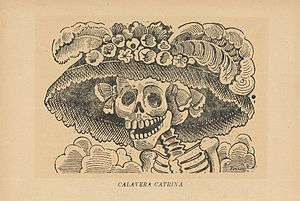Death (personification)
Death is frequently imagined as a personified force. In some mythologies, a character known as the Grim Reaper causes the victim's death by coming to collect that person's soul. Other beliefs hold that the Spectre of Death is only a psychopomp, serving to sever the last ties between the soul and the body, and to guide the deceased to the afterlife, without having any control over when or how the victim dies. Death is most often personified in male form, although in certain cultures Death is perceived as female (for instance, Marzanna in Slavic mythology, Dhumavati in Indian mythology, or La Catrina in Mexico).

By region
Zoroastrianism
ASTWIHĀD (Av. Astō.vīδōtu, lit. “he who dissolves the bones, bone-breaker, divider of the body”), the demon of death in the Avesta (Vd. 4.49, 5.8-9) and later Zoroastrian texts. He destroys life in cooperation with Vāyu, and none can escape him (Aogəmadaēčā 57.73). In Pahlavi literature he is identified with the Evil Wāy (q.v.): “Astwihād is the Evil Wāy who carries the breath-soul away. As it is said: When he touches a man with his hand, it is sleep; when he casts his shadow on him, it is fever; and when he looks upon him with his eyes, he deprives him of the breath-soul” (Bundahišn, p. 186.12). Astwihād was sent by Ahriman to cast his fatal noose on Gayōmard (cf. the noose of Vedic Yama), and he is one of the evil assessors of the soul at its judgment. His meaning is summed up in Dādestān ī Dēnīg 36.38: “Astwihād is explained as the disintegration of material beings” (astwihād wizārīhēd astōmandān wišōbagīh).
Middle Eastern
The Canaanites of the 12th- and 13th-century BC Levant personified death as the god Mot (lit. "Death"). He was considered a son of the king of the gods, El. His contest with the storm god Baʿal forms part of the myth cycle from the Ugaritic texts. The Phoenicians also worshipped death under the name Mot and a version of Mot later became Maweth, the devil or angel of death in Judaism.[1][2]
Hellenic
In Ancient Greek religion and Greek mythology, Death (Thanatos) is one of the twin sons of Nyx (night). Like her, he is seldom portrayed directly. He sometimes appears in art as a winged and bearded man, and occasionally as a winged and beardless youth. When he appears together with his twin brother, Hypnos, the god of sleep, Thanatos generally represents a gentle death. Thanatos, led by Hermes psychopompos, takes the shade of the deceased to the near shore of the river Styx, whence the ferryman Charon, on payment of a small fee, conveys the shade to Hades, the realm of the dead. Homer's Iliad 16.681, and the Euphronios Krater's depiction of the same episode, have Apollo instruct the removal of the heroic, semi-divine Sarpedon's body from the battlefield by Hypnos and Thanatos, and conveyed thence to his homeland for proper funeral rites. Among the other children of Nyx are Thanatos' sisters, the Keres, blood-drinking, vengeant spirits of violent or untimely death, portrayed as fanged and taloned, with bloody garments.
Celtic
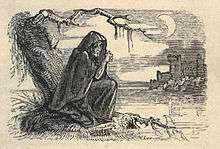
In Breton folklore, a spectral figure called the Ankou (yr Angau in Welsh) portends death. Usually, the Ankou is the spirit of the last person that died within the community and appears as a tall, haggard figure with a wide hat and long white hair or a skeleton with a revolving head. The Ankou drives a deathly wagon or cart with a creaking axle. The cart or wagon is piled high with corpses and a stop at a cabin means instant death for those inside.[3]
Irish mythology features a similar creature known as a dullahan, whose head would be tucked under his or her arm (dullahans were not one, but an entire species). The head was said to have large eyes and a smile that could reach the head's ears. The dullahan would ride a black horse or a carriage pulled by black horses, and stop at the house of someone about to die, and call their name, and immediately the person would die. The dullahan did not like being watched, and it was believed that if a dullahan knew someone was watching them, they would lash that person's eyes with their whip, which was made from a spine; or they would toss a basin of blood on the person, which was a sign that the person was next to die.
Gaelic lore also involves a female spirit known as Banshee (Modern Irish Gaelic: bean sí pron. banshee, literally fairy woman), who heralds the death of a person by shrieking or keening. The banshee is often described as wearing red or green, usually with long, disheveled hair. She can appear in a variety of forms, typically that of an ugly, frightful hag, but in some stories she chooses to appear young and beautiful. Some tales recount that the creature was actually a ghost, often of a specific murdered woman or a mother who died in childbirth. When several banshees appeared at once, it was said to indicate the death of someone great or holy. In Ireland and parts of Scotland, a traditional part of mourning is the keening woman (bean chaointe), who wails a lament – in Irish: Caoineadh, caoin meaning "to weep, to wail."
In Scottish folklore there was a belief that a black, dark green or white dog known as a Cù Sìth took dying souls to the afterlife. Comparable figures exist in Irish and Welsh stories.
In Welsh Folklore, Gwyn ap Nudd is the escort of the grave, the personification of Death and Winter who leads the wild hunt to collect wayward souls and escort them to the Otherworld, sometimes it is Melwas, Arawn or Afallach in a similar position.
Latin America
As is the case in many Romance languages (including French, Portuguese, Italian, and Romanian), the Spanish word for death, muerte, is a feminine noun. As such, it is common in Spanish-speaking cultures to personify death as a female figure.
In Aztec mythology, Mictecacihuatl is the "Queen of Mictlan" (the Aztec underworld), ruling over the afterlife with her husband Mictlantecuhtli. Other epithets for her include "Lady of the Dead," as her role includes keeping watch over the bones of the dead. Mictecacihuatl was represented with a fleshless body and with jaw agape to swallow the stars during the day. She presided over the ancient festivals of the dead, which evolved from Aztec traditions into the modern Day of the Dead after synthesis with Spanish cultural traditions.
Our Lady of the Holy Death (Santa Muerte) is a female deity or folk saint of Mexican folk religion, whose popularity has been growing in Mexico and the United States in recent years. Since the pre-Columbian era, Mexican culture has maintained a certain reverence towards death, as seen in the widespread commemoration of the Day of the Dead. La Calavera Catrina, a character symbolizing death, is also an icon of the Mexican Day of the Dead.
San La Muerte (Saint Death) is a skeletal folk saint venerated in Paraguay, northeast Argentina, and southern Brazil. As the result of internal migration in Argentina since the 1960s, the veneration of San La Muerte has been extended to Greater Buenos Aires and the national prison system as well. Saint Death is depicted as a male skeleton figure usually holding a scythe. Although the Catholic Church in Mexico has attacked the devotion of Saint Death as a tradition that mixes paganism with Christianity and is contrary to the Christian belief of Christ defeating death, many devotees consider the veneration of San La Muerte as being part of their Catholic faith. The rituals connected and powers ascribed to San La Muerte are very similar to those of Santa Muerte; the resemblance between their names, however, is coincidental.
In Guatemala, San Pascualito is a skeletal folk saint venerated as "King of the Graveyard." He is depicted as a skeletal figure with a scythe, sometimes wearing a cape and crown. He is associated with death and the curing of diseases.
In the Brazilian religion Umbanda, the orixá Omolu personifies sickness and death as well as healing. The image of the death is also associated with Exu, lord of the crossroads, who rules cemeteries and the hour of midnight.
In Haitian Vodou, the Guédé are a family of spirits that embody death and fertility. The most well-known of these spirits is Baron Samedi.
Slavic
_3.jpg)
In Poland, Death, or Śmierć, has an appearance similar to the Grim Reaper, although Śmierć's robe is white instead of black. Because the word śmierć is feminine in gender, death is frequently portrayed as a skeletal old woman, as depicted in 15th-century dialogue "Rozmowa Mistrza Polikarpa ze Śmiercią" (Latin: "Dialogus inter Mortem et Magistrum Polikarpum").
In Serbia and other Slavic countries, the Grim Reaper is well known as Smrt ("Death") or Kosač ("Billhook"). Slavic people found this very similar to the Devil and other dark powers. One popular saying about death is: Smrt ne bira ni vreme, ni mesto, ni godinu ("Death does not choose a time, place or year" – which means death is destiny.)
In the Czech Republic, the medieval Prague Astronomical Clock carries a depiction of Death striking the hour. A version first appeared in 1490.[4][5]
The Low Countries
In the Netherlands, and to a lesser extent in Belgium, the personification of Death is known as Magere Hein ("Meager Hein") or Pietje de Dood ("Peter the Death").[6] Historically, he was sometimes simply referred to as Hein or variations thereof such as Heintje, Heintjeman and Oom Hendrik ("Uncle Hendrik"). Related archaic terms are Beenderman ("Bone-man"), Scherminkel (very meager person, "skeleton") and Maaijeman ("mow-man", a reference to his scythe).[7]
The concept of Magere Hein predates Christianity, but was Christianized and likely gained its modern name and features (scythe, skeleton, black robe etc.) during the Middle Ages. The designation "Meager" comes from its portrayal as a skeleton, which was largely influenced by the Christian "Dance of Death" (Dutch: dodendans) theme that was prominent in Europe during the late Middle Ages. "Hein" was a Middle Dutch name originating as a short form of Heinric (see Henry (given name)). Its use was possibly related to the comparable German concept of "Freund Hein." Notably, many of the names given to Death can also refer to the Devil; it is likely that fear of death lead to Hein's character being merged with that of Satan.[7][8]
In Belgium, this personification of Death is now commonly called Pietje de Dood "Little Pete, the Death."[9] As with other Dutch names, it can also refer to the Devil.[10]
Scandinavia
_by_Johannes_Gehrts.jpg)
In Scandinavia, Norse mythology personified death in the shape of Hel, the goddess of death and ruler over the realm of the same name, where she received a portion of the dead.[11] In the times of the Black Plague, Death would often be depicted as an old woman known by the name of Pesta, meaning "plague hag," wearing a black hood. She would go into a town carrying either a rake or a broom. If she brought the rake, some people would survive the plague; if she brought the broom, however, everyone would die.[12]
Scandinavians later adopted the Grim Reaper with a scythe and black robe. Today, Ingmar Bergman's film The Seventh Seal features one of the world's most famous representations of this personification of Death.
Baltic
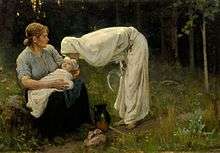
Latvians named Death Veļu māte, but for Lithuanians is was Giltinė, deriving from the word gelti ("to sting"). Giltinė was viewed as an old, ugly woman with a long blue nose and a deadly poisonous tongue. The legend tells that Giltinė was young, pretty, and communicative until she was trapped in a coffin for seven years. Her sister was the goddess of life and destiny, Laima, symbolizing the relationship between beginning and end.
Like the Scandinavians, Lithuanians and Latvians later began using Grim Reaper imagery for death.
India
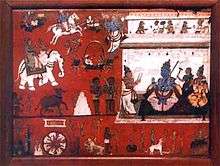
The Sanskrit word for death is mrityu (cognate with Latin mors and Lithuanian mirtis), which is often personified in Dharmic religions.
In Hindu scriptures, the lord of death is called King Yama (यम राज, Yama Rājā). He is also known as the King of Karmic Justice (Dharmaraja) as one's karma at death was considered to lead to a just rebirth. Yama rides a black buffalo and carries a rope lasso to lead the soul back to his home, called Naraka, pathalloka, or Yamaloka. There are many forms of reapers, although some say there is only one who disguises himself as a small child. His agents, the Yamadutas, carry souls back to Yamalok. There, all the accounts of a person's good and bad deeds are stored and maintained by Chitragupta. The balance of these deeds allows Yama to decide where the soul should reside in its next life, following the theory of reincarnation. Yama is also mentioned in the Mahabharata as a great philosopher and devotee of the Supreme Brahman.
Buddhist scriptures also mention the figure Mara much in the same way.
East Asia
Yama was introduced to Chinese mythology through Buddhism. In Chinese, he is known as King Yan (t 閻王, s 阎王, p Yánwáng) or Yanluo (t 閻羅王, s 阎罗王, p Yánluówáng), ruling the ten gods of the underworld Diyu. He is normally depicted wearing a Chinese judge's cap and traditional Chinese robes and appears on most forms of hell money offered in ancestor worship. From China, Yama spread to Japan as the Great King Enma (閻魔大王, Enma-Dai-Ō), ruler of Jigoku (地獄); Korea as the Great King Yeomna (염라대왕), ruler of Jiok (지옥); and Vietnam as Diêm La Vương, ruler of Địa Ngục or Âm Phủ.
Separately, In Korean mythology, death's principal figure is the "Netherworld Emissary" Jeoseungsaja (저승사자, shortened to Saja (사자)). He is depicted as a stern and ruthless bureaucrat in Yeomna's service. A psychopomp, he escorts all—good or evil—from the land of the living to the netherworld when the time comes.[13] One of the representative names is Ganglim (강림), the Saja who guides the soul to the entrance of the underworld. According to legend, he always carries Jeokpaeji (적패지), the list with the names of the dead written on a red cloth. When he calls the name on Jeokpaeji three times, the soul leaves the body and follows him inevitably.
the Kojiki relates that the Japanese goddess Izanami was burnt to death giving birth to the fire god Hinokagutsuchi. She then entered a realm of perpetual night called Yomi-no-Kuni. Her husband Izanagi pursued her there but discovered his wife was no longer as beautiful as before. After an argument, she promised she would take a thousand lives every day, becoming a goddess of death. There are also death gods called shinigami (死神), which are closer to the Western tradition of the Grim Reaper; while common in modern Japanese arts and fiction, they were essentially absent in traditional mythology.
In Abrahamic religions
The "Angel of the Lord" smites 185,000 men in the Assyrian camp (II Kings 19:35). When the Angel of Death passes through to smite the Egyptian first-born, God prevents "the destroyer" (shâchath) from entering houses with blood on the lintel and side posts (Exodus 12:23). The "destroying angel" (mal'ak ha-mashḥit) rages among the people in Jerusalem (II Sam. 24:16). In I Chronicles 21:15 the "angel of the Lord" is seen by King David standing "between the earth and the heaven, having a drawn sword in his hand stretched out over Jerusalem." The biblical Book of Job (33:22) uses the general term "destroyers" (memitim), which tradition has identified with "destroying angels" (mal'ake Khabbalah), and Prov. 16:14 uses the term the "angels of death" (mal'ake ha-mavet). The angel Azra'il is sometimes referred as the Angel of Death as well.[14]:64–65
Jewish tradition also refers to Death as the Angel of Dark and Light, a name which stems from Talmudic lore. There is also a reference to "Abaddon" (The Destroyer), an angel who is known as the "Angel of the Abyss". In Talmudic lore, he is characterized as archangel Michael.[15]
In Judaism
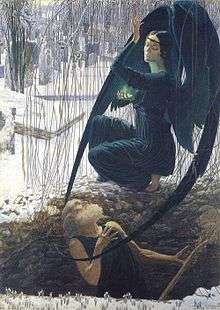
In Hebrew scriptures, Death ("Maweth/Mavet(h)") is sometimes personified as a devil or angel of death (e.g., Habakkuk 2:5; Job 18:13).[1] In both the Book of Hosea and the Book of Jeremiah, Maweth/Mot is mentioned as a deity to whom Yahweh can turn over Judah as punishment for worshiping other gods.[16] The memitim are a type of angel from biblical lore associated with the mediation over the lives of the dying. The name is derived from the Hebrew word mĕmītǐm (מְמִיתִים – "executioners", "slayers", "destroyers") and refers to angels that brought about the destruction of those whom the guardian angels no longer protected.[17] While there may be some debate among religious scholars regarding the exact nature of the memitim, it is generally accepted that, as described in the Book of Job 33:22, they are killers of some sort.[18]
Form and functions
According to the Midrash, the Angel of Death was created by God on the first day.[19] His dwelling is in heaven, whence he reaches earth in eight flights, whereas Pestilence reaches it in one.[20] He has twelve wings.[21] "Over all people have I surrendered thee the power," said God to the Angel of Death, "only not over this one [i.e. Moses] which has received freedom from death through the Law."[22] It is said of the Angel of Death that he is full of eyes. In the hour of death, he stands at the head of the departing one with a drawn sword, to which clings a drop of gall. As soon as the dying man sees Death, he is seized with a convulsion and opens his mouth, whereupon Death throws the drop into it. This drop causes his death; he turns putrid, and his face becomes yellow.[23] The expression "the taste of death" originated in the idea that death was caused by a drop of gall.[24]
The soul escapes through the mouth, or, as is stated in another place, through the throat; therefore, the Angel of Death stands at the head of the patient (Adolf Jellinek, l.c. ii. 94, Midr. Teh. to Ps. xi.). When the soul forsakes the body, its voice goes from one end of the world to the other, but is not heard (Gen. R. vi. 7; Ex. R. v. 9; Pirḳe R. El. xxxiv.). The drawn sword of the Angel of Death, mentioned by the Chronicler (I. Chron. 21:15; comp. Job 15:22; Enoch 62:11), indicates that the Angel of Death was figured as a warrior who kills off the children of men. "Man, on the day of his death, falls down before the Angel of Death like a beast before the slaughterer" (Grünhut, "Liḳḳuṭim", v. 102a). R. Samuel's father (c. 200) said: "The Angel of Death said to me, 'Only for the sake of the honor of mankind do I not tear off their necks as is done to slaughtered beasts'" ('Ab. Zarah 20b). In later representations, the knife sometimes replaces the sword, and reference is also made to the cord of the Angel of Death, which indicates death by throttling. Moses says to God: "I fear the cord of the Angel of Death" (Grünhut, l.c. v. 103a et seq.). Of the four Jewish methods of execution, three are named in connection with the Angel of Death: Burning (by pouring hot lead down the victim's throat), slaughtering (by beheading), and throttling. The Angel of Death administers the particular punishment that God has ordained for the commission of sin.
A peculiar mantle ("idra"—according to Levy, "Neuhebr. Wörterb." i. 32, a sword) belongs to the equipment of the Angel of Death (Eccl. R. iv. 7). The Angel of Death takes on the particular form which will best serve his purpose; e.g., he appears to a scholar in the form of a beggar imploring pity (the beggar should receive Tzedakah)(M. Ḳ. 28a). "When pestilence rages in the town, walk not in the middle of the street, because the Angel of Death [i.e., pestilence] strides there; if peace reigns in the town, walk not on the edges of the road. When pestilence rages in the town, go not alone to the synagogue, because there the Angel of Death stores his tools. If the dogs howl, the Angel of Death has entered the city; if they make sport, the prophet Elijah has come" (B. Ḳ. 60b). The "destroyer" (saṭan ha-mashḥit) in the daily prayer is the Angel of Death (Ber. 16b). Midr. Ma'ase Torah (compare Jellinek, "B. H." ii. 98) says: "There are six Angels of Death: Gabriel over kings; Ḳapẓiel over youths; Mashbir over animals; Mashḥit over children; Af and Ḥemah over man and beast."
Scholars and the Angel of Death
_-_BEIC_6342929.jpg)
Talmud teachers of the 4th century associate quite familiarly with him. When he appeared to one on the street, the teacher reproached him with rushing upon him as upon a beast, whereupon the angel called upon him at his house. To another, he granted a respite of thirty days, that he might put his knowledge in order before entering the next world. To a third, he had no access, because he could not interrupt the study of the Talmud. To a fourth, he showed a rod of fire, whereby he is recognized as the Angel of Death (M. K. 28a). He often entered the house of Bibi and conversed with him (Ḥag. 4b). Often, he resorts to strategy in order to interrupt and seize his victim (B. M. 86a; Mak. 10a).
The death of Joshua ben Levi in particular is surrounded with a web of fable. When the time came for him to die and the Angel of Death appeared to him, he demanded to be shown his place in paradise. When the angel had consented to this, he demanded the angel's knife, that the angel might not frighten him by the way. This request also was granted him, and Joshua sprang with the knife over the wall of paradise; the angel, who is not allowed to enter paradise, caught hold of the end of his garment. Joshua swore that he would not come out, and God declared that he should not leave paradise unless he had ever absolved himself of an oath; he had never absolved himself of an oath so he was allowed to remain. The Angel of Death then demanded back his knife, but Joshua refused. At this point, a heavenly voice (bat ḳol) rang out: "Give him back the knife, because the children of men have need of it will bring death." Hesitant, Joshua Ben Levi gives back the knife in exchange for the Angel of Death's name. To never forget the name, he carved Troke into his arm, the Angel of Death's chosen name. When the knife was returned to the Angel, Joshua's carving of the name faded, and he forgot. (Ket. 77b; Jellinek, l.c. ii. 48–51; Bacher, l.c. i. 192 et seq.).
Rabbinic views
The Rabbis found the Angel of Death mentioned in Psalm 89:48, where the Targum translates: "There is no man who lives and, seeing the Angel of Death, can deliver his soul from his hand." Eccl. 8:4 is thus explained in Midrash Rabbah to the passage: "One may not escape the Angel of Death, nor say to him, 'Wait until I put my affairs in order,' or 'There is my son, my slave: take him in my stead.'" Where the Angel of Death appears, there is no remedy, but his name (Talmud, Ned. 49a; Hul. 7b). If one who has sinned has confessed his fault, the Angel of Death may not touch him (Midrash Tanhuma, ed. Buber, 139). God protects from the Angel of Death (Midrash Genesis Rabbah lxviii.).
By acts of benevolence, the anger of the Angel of Death is overcome; when one fails to perform such acts the Angel of Death will make his appearance (Derek Ereẓ Zuṭa, viii.). The Angel of Death receives his orders from God (Ber. 62b). As soon as he has received permission to destroy, however, he makes no distinction between good and bad (B. Ḳ. 60a). In the city of Luz, the Angel of Death has no power, and, when the aged inhabitants are ready to die, they go outside the city (Soṭah 46b; compare Sanh. 97a). A legend to the same effect existed in Ireland in the Middle Ages (Jew. Quart. Rev. vi. 336).
In Christianity
.jpg)
Death is one of the Four Horsemen of the Apocalypse portrayed in the Book of Revelation, in Revelation 6:7–8[25] He is also known as the Pale Horseman whose name is Thanatos, the same as that of the ancient Greek personification of death, and the only one of the horsemen to be named.
Paul addresses a personified death in 1 Corinthians 15:55: O Death, where is your sting? O Hades, where is your victory? In some versions, both arms of this verse are addressed to death.[26]
In Islam
In Islam, Archangel Azrael is the Malak al-Maut (angel of death). He and his many subordinates pull the souls out of the bodies, and guide them through the journey of the afterlife. Their appearance depends on the person's deed and actions, with those that did good seeing a beautiful being, and those that did wrong seeing a horrific monster.
Islamic tradition discusses elaborately as to what exactly happens before, during, and after the death. The angel of death appears to the dying to take out their souls. The sinners' souls are extracted in a most painful way while the righteous are treated easily.[27] After the burial, two angels – Munkar and Nakir – come to question the dead in order to test their faith. The righteous believers answer correctly and live in peace and comfort while the sinners and disbelievers fail and punishments ensue.[27][28] The time period or stage between death and resurrection is called barzakh (the interregnum).[27]
Death is a significant event in Islamic life and theology. It is seen not as the termination of life, rather the continuation of life in another form. In Islamic belief, God has made this worldly life as a test and a preparation ground for the afterlife; and with death, this worldly life comes to an end.[29] Thus, every person has only one chance to prepare themselves for the life to come where God will resurrect and judge every individual and will entitle them to rewards or punishment, based on their good or bad deeds.[29][30] And death is seen as the gateway to and beginning of the afterlife. In Islamic belief, death is predetermined by God, and the exact time of a person's death is known only to God.
Media
Songs
Lethal Temptress by The Mendoza Line
Death is portrayed in this song as a female. The song implies that Death is someone that we give into that ends suffering.[31]
Books
Death (Discworld)
Death is a fictional character in Terry Pratchett's Discworld series, and depicted as one of many Deaths. His jurisdiction is specifically the Discworld itself; he is only a part, or minion, of Azrael, the universal Death. Death has appeared in every Discworld novel, with the exception of The Wee Free Men and Snuff. Mort published in 1987 is the first time Death is the leading character.[32]
Death (The Book Thief)
Death is the narrator of Markus Zusak’s 2005 novel The Book Thief. As the collector of souls, he tells the coming of age story about a young girl in Nazi Germany and World War II.[33]
Death (Harry Potter)
Death appears in "The Tale of Three Brothers in J.K. Rowling's The Tales of Beedle the Bard, a collection of fairytales featured in her Harry Potter series. Three brothers avoid Death and Death, furious at being avoided offers the brothers gifts. Two of these gifts, the Elder Wand and the Resurrection Stone lead to the first two brothers' deaths. The third brother, gifted with the Invisibility Cloak avoids Death until old age, where he then goes with Death like an old friend. These gifts became the Deathly Hallows.[34]
Death (Incarnations of Immortality)
Death is a held office in Piers Anthony's 1983 novel On a Pale Horse.[35] The character Zane becomes Death after a failed suicide attempt that ends up killing the previous Death. He is taught by his fellow Incarnations Time and Fate and must defeat the Incarnation of Evil, Satan. He is given several items to aid him on his job, including a watch to stop local time, jewels to measure how much good and evil is in a person for judgment, and his pale horse Mortis, who often takes the form of a pale car. Zane as Death appears in Anthony’s following novels, notably Bearing an Hourglass.
Charlie Asher (A Dirty Job)
Death is a career in Christopher Moore’s A Dirty Job.[36] Charlie Asher is chosen to be a “Death Merchant” for retrieving souls and protect them from dark forces while managing his story and raising his newborn daughter.
Comics
Death (DC Comics)
Death first appeared in The Sandman vol. 2, #8 (August 1989), and was created by Neil Gaiman and Mike Dringenberg.[37] She is both an embodyiment of death and a psychopomp in The Sandman Universe, and depicted as a down to earth, perky, and nurturing figure. Death is the second born of The Endless and she states “When the last living thing dies, my job will be finished. I'll put the chairs on the tables, turn out the lights and lock the universe behind me when I leave.”[38]
Death also appears briefly in Fables #11 (May 2003) titled “Bag O' Bones”, where Jack Horner traps Death in a magical bag that never gets full.[39] There has been no indication as to whether Fables has any connection to the Sandman universe.
Death (Marvel Comics)
The character first appeared in Captain Marvel #26 (Jun. 1973) and was created by Mike Friedrich and Jim Starlin. Death is an abstract entity, the embodiment of the end of life in the Marvel Universe, and resides inside a pocket dimension known as the Realm of Death.[40] The character can change appearance at will shown in a storyline of Captain Marvel where Thanos' scheme to conquer the universe, as the character becomes determined to prove his love for Death by destroying all life.
Lady MacDeath (Bug-a-Boo)
Lady MacDeath is a Grim Reaper, the personification of Death who is responsible of going after all people whose time to die has come, although unlike a typical Grim Reaper, her body is not pictured as made of bones. She uses her sickle to kill people, by hitting them in the head, and then she takes their souls to the purgatory, for them to be judged and sent whether to hell or heaven (sometimes after much bureaucracy). She always carries a list with the name of the people she must kill on the day. Most of her stories feature a pursuit, sometimes punctuated with struggles faced every day by normal people. Maurício de Souza says that the purpose of creating her is "taking death less seriously, while it doesn't come to us".
Film
Death Takes a Holiday (1934)
After years of questioning why people fear him, Death takes on human form for three days so that he can mingle among mortals and find an answer. He finds a host in Duke Lambert after revealing himself and his intentions to the Duke, and takes up temporary residence in the Duke's villa. However, events soon spiral out of control as Death falls in love with the beautiful young Grazia. As he does so, Duke Lambert, the father of Grazia's mortal lover Corrado, begs him to give Grazia up and leave her among the living. Death must decide whether to seek his own happiness, or sacrifice it so that Grazia may live.
The 1998 American film Meet Joe Black is loosely based on the 1934 film. While on Earth, Death, living under the name Joe Black, enlists the wealthy Bill Parrish to be his guide to mortal life, and in exchange guarantees that Bill will not die as long as he serves as "Joe's" guide. Joe falls in love with Bill's youngest daughter, Susan, a resident in internal medicine, and learns the meaning of both friendship and love.
The Seventh Seal (1957)
Death is one of the main characters in 1957 Swedish historical fantasy film The Seventh Seal. The film tells the story of a knight encountering Death, whom he challenges to a chess match, believing he can survive as long as the game continues.[41]
These scenes are parodied in the 1991 comedy film Bill & Ted's Bogus Journey, in which the title characters repeatedly beat Death playing a variety of family board games such as Battleships and Twister. Death goes on to accompany Bill and Ted for the remainder of the film as a major supporting character.[42]
The Adventures of Baron Munchausen (1988)
Throughout the film, Munchausen is pursued by Death, a skeletal angel with raven's wings, carrying a scythe in one hand and an hourglass in the other. At the end, Death, in the form of a grim physician, extracts Munchausen's glowing life force, and Munchausen is given a lavish funeral before boldly claiming it was "one of the many times I faced Death."
Final Destination film series (2000–2011)
In each of the Final Destination films, a group of protagonists escapes a disaster in which many innocent people are killed. Their escapes alter the design intended by Death, which, while never portrayed as a physical entity, is instead described as an omniscient supernatural consciousness. In each film, the characters learn that they are doomed to be killed, and that Death will follow them, leading them each into misadventure until they eventually die.
Gallery
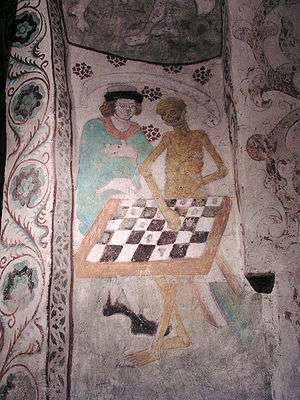 Medieval painting of Death playing chess from Täby Church in Sweden
Medieval painting of Death playing chess from Täby Church in Sweden Death personified in Punch.
Death personified in Punch.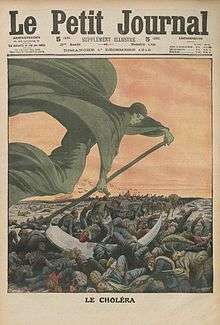 Death by Cholera personified as a Reaper in Le Petit Journal.
Death by Cholera personified as a Reaper in Le Petit Journal. Death personified in de Vauce-Hours by Jean Fouquet.
Death personified in de Vauce-Hours by Jean Fouquet.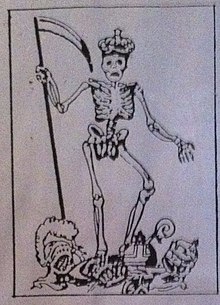 A religious image of San Pascualito, a folk Saint of death, wielding a scythe.
A religious image of San Pascualito, a folk Saint of death, wielding a scythe.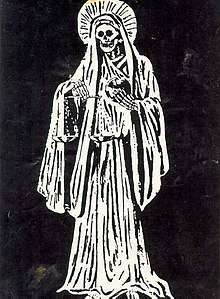 Art from a votive candle of Santa Muerte.
Art from a votive candle of Santa Muerte.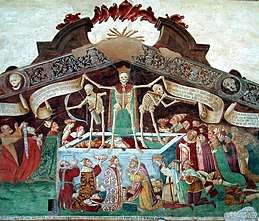
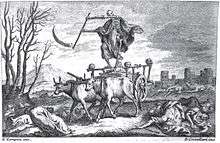 Illustration of Petrarch's Triumph of Death.
Illustration of Petrarch's Triumph of Death.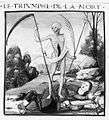 Illustration of Petrarch's Triumph of Death.
Illustration of Petrarch's Triumph of Death.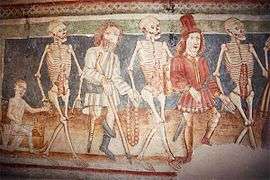 The Danse Macabre in the Holy Trinity Church in Hrastovlje, Slovenia
The Danse Macabre in the Holy Trinity Church in Hrastovlje, Slovenia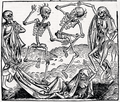 The Dance of Death (1493) by Michael Wolgemut
The Dance of Death (1493) by Michael Wolgemut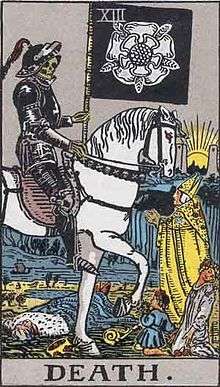 Death Tarot card
Death Tarot card 1/9 Insignia
1/9 Insignia- De triomf van de dood, by James Ensor, 1887, Royal Museum of Fine Arts Antwerp
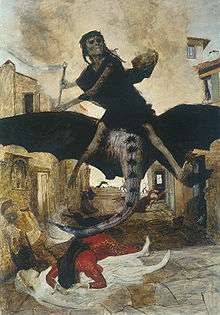 Plague (1898) by Arnold Böcklin, tempera on wood
Plague (1898) by Arnold Böcklin, tempera on wood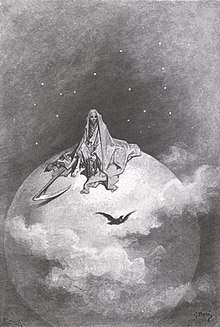 An Illustration by Gustave Doré from "The Raven"
An Illustration by Gustave Doré from "The Raven"
See also
Notes
- Cassuto, U. (1962). "Baal and Mot in the Ugaritic Texts". Israel Exploration Journal. 12 (2): 81–83. JSTOR 27924890.
- See, e.g., Hab. 2:5 & Job 18:13.
- Anatole Le Braz : Légende de la Mort
- "History of the Astronomical Clock". prague.eu.
- "Brief history of the Prague Astronomical Clock". orloj.eu.
- "Het Vlaams woordenboek » Pietje de Dood". www.vlaamswoordenboek.be. Retrieved 21 January 2019.
- Niermeyer, Antonie (1840). Verhandeling over het booze wezen in het bijgeloof onzer natie: eene bijdrage tot de kennis onzer voorvaderlijke mythologie [Treatise on the evil being in the superstition of our nation: a contribution to the knowledge of our ancestral mythology] (in Dutch). Rotterdam: A. Wijnands. pp. 32–33. Retrieved 23 May 2016 – via Ghent University.
- Lemma: Hein, INL
- "'Pietje de Dood' jaagt mensen de stuipen op het lijf in de VS". Retrieved 26 January 2018.
- "Nederlandse Volksverhalenbank – Duivel". www.verhalenbank.nl. Retrieved 26 January 2018.
- "Hel (Norse deity) – Encyclopædia Britannica". Global.britannica.com. Retrieved 8 December 2013.
- "død – folketro – Store norske leksikon". Snl.no. Archived from the original on 12 December 2013. Retrieved 8 December 2013.
- "The Korean National Encyclopedia of Ethnic Practices (Page in Korean)". 210.204.213.131. Archived from the original on 10 June 2015. Retrieved 16 November 2013.
- Davidson, Gustav (1967), A Dictionary of Angels, Including the Fallen Angels, ISBN 9780029070505
- Bunson, Matthew, (1996). Angels A to Z : Who's Who of the Heavenly Host. Three Rivers Press. ISBN 0-517-88537-9.
- Handy, Lowell (1995). The Appearance of the Pantheon in Judah in The Triumph of Elohim. Grand Rapids, Michigan, USA: Eerdmans. p. 40. ISBN 0-8028-4161-9.
- Olyan, S.M., A Thousand Thousands Served Him: Exegesis and the Naming of Angels in Ancient Judaism, page 21.
- Gordon, M.B., Medicine among the Ancient Hebrews, page 472.
- Midrash Tanhuma on Genesis 39:1
- Talmud Berakhot 4b
- Pirke De-Rabbi Eliezer 13
- Midrash Tanhuma on Exodus 31:18
- Talmud Avodah Zarah 20b; on putrefaction see also Pesikta de-Rav Kahana 54b; for the eyes compare Ezekiel 1:18 and Revelation 4:6
- Jewish Quarterly Review vi. 327
- "Bible Gateway passage: Revelation 6:7–8 – New American Standard Bible". Bible Gateway. Retrieved 26 January 2018.
- 1 Corinthians 15:55 in the American Standard Version and the New Revised Standard Version
- Matt Stefon, ed. (2010). Islamic Beliefs and Practices. New York: Britannica Educational Publishing. pp. 83–85. ISBN 978-1-61530-060-0.
- Nigosian, S. A. (2004). Islam: Its History, Teaching, and Practices. Indiana University Press. pp. 123–4. ISBN 0-253-21627-3.
- Oliver Leaman, ed. (2006). The Qur'an: An Encyclopedia. Routledge. p. 27. ISBN 978-0-415-32639-1 https://books.google.com/books?id=isDgI0-0Ip4C&pg=PA27. Missing or empty
|title=(help) - Juan E. Campo, ed. (2009). Encyclopedia of Islam. Facts on File. p. 185. ISBN 978-0-8160-5454-1 https://books.google.com/books?id=OZbyz_Hr-eIC&pg=PA185. Missing or empty
|title=(help) - https://www.youtube.com/watch?v=XLyz5TssWHo
- Probably inspired by the third/first God of Death. Samka was the first Murderer and then there was the first Suicide, then The Dawn then Life and Death as you know it. Then Satan then Xkysarah.
- Zusak, Markus. (2007). Book Thief, The. Random House US. ISBN 978-0-375-84220-7. OCLC 1031963215.
- Rowling, J.K. (2008). Children's High-Level Group in association with Bloomsbury Publishing Plc. ISBN 9780545128285. OCLC 1089611853.
- Anthony, Piers. (1983). On a Pale Horse. Del Rey Books. ISBN 9780307815651 030781565X. OCLC Number 1002079730
- Moore, Christopher. (2006 ). A Dirty Job. Harper Collins. ISBN 9780060590284 0060590289. OCLC 972135687.
- Irvine, Alexander (Alexander C.) (2008). The vertigo encyclopedia. Dougall, Alastair. London: Dorling Kindersley. ISBN 978-1-4053-2890-6. OCLC 213309015.
- Gaiman, Neil. (1995). The sandman : dream country. New York: DC Comics. ISBN 1-56389-016-X. OCLC 37703435.
- Willingham, Bill. Fables. Hamilton, Craig, 1964–, Klein, Todd,, Leialoha, Steve,, Medina, Lan,, Van Valkenburgh, Sherilyn,, Buckingham, Mark. New York, NY. ISBN 978-1-56389-942-3. OCLC 51701873.
- Starlin, Jim. (1990). The Thanos quest. Part 2, Games and prizes. Lim, Ronald., Beatty, John., Vincent, Tom., Bruzenak, Ken., Anderson, Craig. New York: Marvel Comics. ISBN 0-87135-682-1. OCLC 23182698.
- Bergman, Ingmar, 1918–2007. (1993). The seventh seal. Faber and Faber. ISBN 0-571-17098-6. OCLC 66019252.CS1 maint: multiple names: authors list (link)
- "Bill & Ted's Bogus Journey". Washington Post. 26 July 1991.
Bibliography
- Bender, A. P. (January 1894). "Beliefs, Rites, and Customs of the Jews, Connected with Death, Burial, and Mourning". The Jewish Quarterly Review. 6 (2): 317–347. doi:10.2307/1450143. JSTOR 1450143.
- Bender, A. P. (July 1894). "Beliefs, Rites, and Customs of the Jews, Connected with Death, Burial, and Mourning". The Jewish Quarterly Review. 6 (4): 664–671. doi:10.2307/1450184. JSTOR 1450184.
- Böklen, Ernst (1902). Die Verwandtschaft der Jüdisch-Christlichen mit der Parsischen Eschatologie. Göttingen: Vendenhoeck & Ruprecht.
- Cantu, Dean (March 2018). "Memento Mori: The Personification of Death." TEDxTalk, University of Tulsa. https://www.youtube.com/watch?v=lvnnqRy6ctI
- Dillmann, August (1895). Handbuch der alttestamentlichen Theologie. Leipzig: S. Hirzel.
- Gordon, Maurice Bear (December 1941). "Medicine among the Ancient Hebrews". Isis. 33 (4): 454–485. doi:10.1086/358601. JSTOR 330623.
- Hamburger, J[acob] (1884). "Tod". Real-Encyclopädie für Bibel und Talmud: Wörterbuch zum handgebrauch für Bibelfreunde, Theologen, Juristen, Gemeinde- und Schulvorsteher, Lehrer &c (in German). 1. Strelitz, Mecklenburg: Selbstverlag des Verfassers. pp. 990–992. OCLC 234124918. Retrieved 3 March 2013.
- Joël, David (1881). Der Aberglaube und die Stellung des Judenthums zu Demselben. Breslau: F.W. Jungfer's Buch.

- Kohut, Alexander (1866). Ueber die Jüdische Angelologie und Dämonologie in Ihrer Abhängigkeit vom Parsismus. Leipzig: Brockhaus.
- Lynette, Rachel (2009). The Grim Reaper. Monsters. Farmington Hills, MI: KidHaven Press. ISBN 978-0-7377-4568-9. OCLC 317921894.
- Milton, John. Paradise Lost.
- Olyan, Saul M. (1993). A Thousand Thousands Served Him: Exegesis and the Naming of Angels in Ancient Judaism. Texte und Studien zum antiken Judentum, 36. Tübingen: J.C.B. Mohr. ISBN 978-3-16-146063-0. OCLC 28328810.
- Schwab, Moïse (1897). Vocabulaire de l'Angélologie d'Après les Manuscrits Hebreux de la Bibliothèque Nationale. Paris.
- Stave, Erik (1898). Ueber den Einfluss des Parsismus auf das Judenthum. Haarlem: E. F. Bohn.
- Weber, F. W. (1897). Jüdische Theologie auf Grund des Talmud und verwandter Schriften, gemeinfasslich dargestellt. Leipzig: Dörffling & Franke.
- Hunter, Dave. Reapers inc.
External links
| Wikimedia Commons has media related to personification of Death. |
- Korea National Encyclopedia of Ethnic Practices (in Korean)
